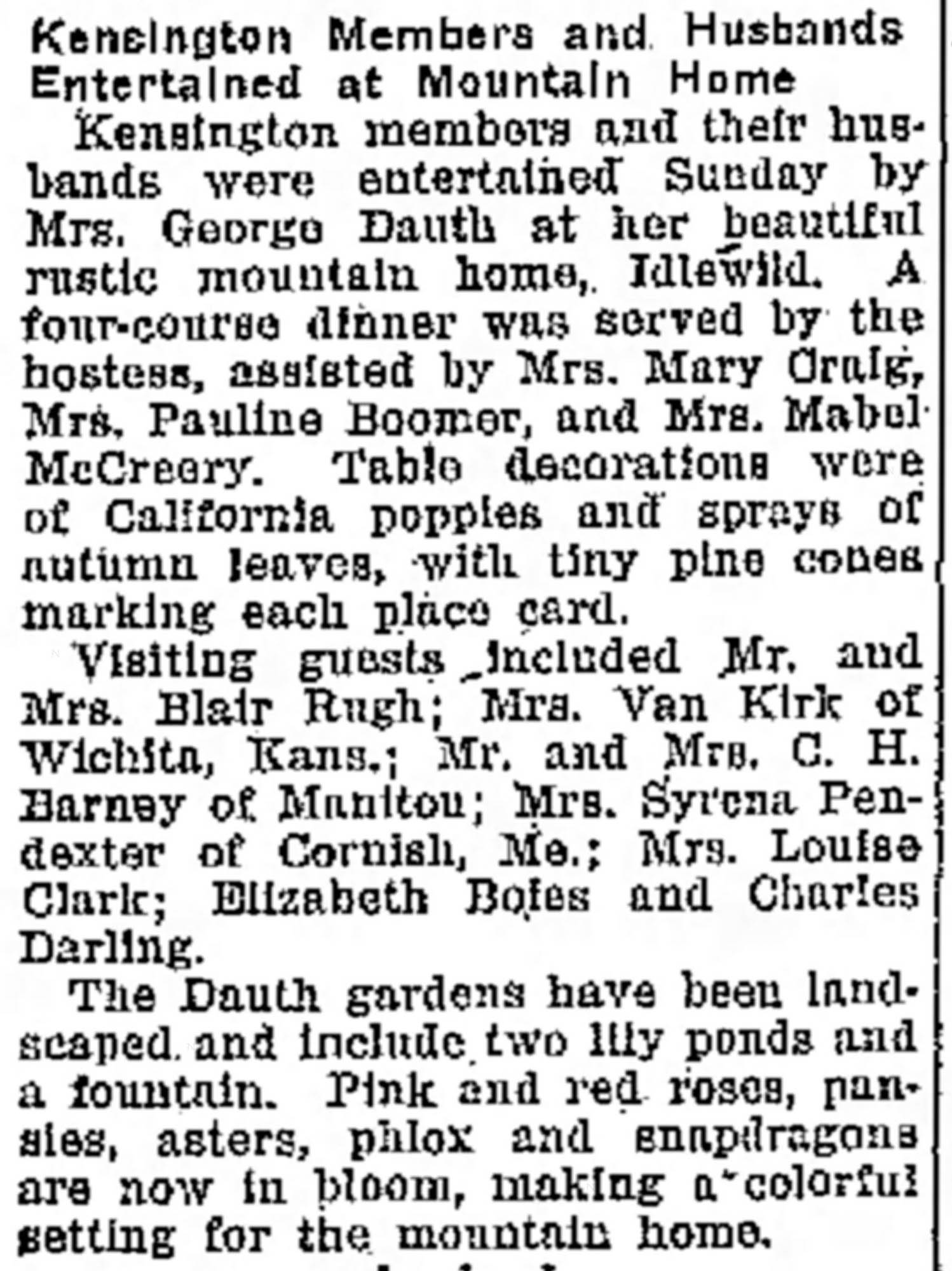Despite having a river run through it, the Big Thompson is an arid place, where life clings to where the water flows.
The secret to Idlewild’s early success as a settlement was its fortuitous access to water. The canyon’s earliest trapper, Frank Marvin, found a spring in Idlewild’s deepest valley and built a shelter by its creekside. Decades later, the Knapps located the Big Thompson’s first first logging camp just a few hundred feet from its source. When Ella Van Bramer began homesteading Idlewild, she used the cold spring water to preserve milk and butter for her guests. After Harvey Witwer purchased Idlewild, spring water was piped into Idlewild Lodge making it the first building here with a running bath.
However the amount of water from this spring was never enough for anything more. Only one cabin would have a spring water tap, and after the loggers came through, it seemed the land could only be used for pasturing.
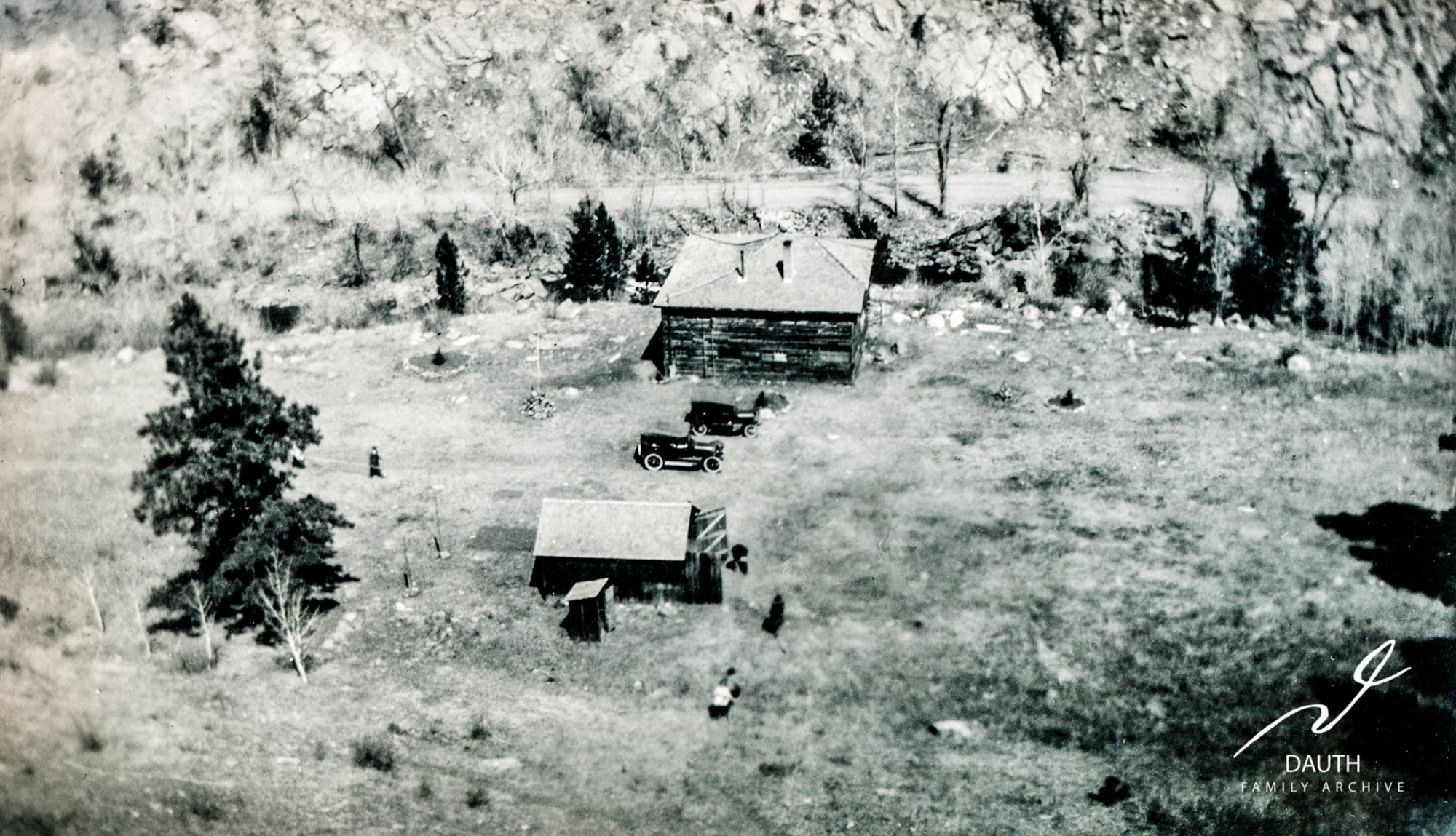
Photo c. 1920 showing the treeless landscape around Idlewild Lodge. Harvey Witwer, who owned the property up to 1920, advertised Idlewild’s usage as stock ranch.1Loveland Daily Herald, 4 Apr. 1918. Colorado Historic Newspapers Collection. Colorado State Library.
But all this changed in 1925, when Loveland’s Idylwilde Hydroelectric Project reached completion. Its construction involved the laying of nearly two miles of pipeline from Idylewilde Dam to Loveland’s power plant at Viestenz-Smith Mountain Park.2ERO Resources Corporation. (2011). Cultural And Historic Resources Idylwilde Hydroelectric Project. This route went right through the middle of Idlewild Sub Division.
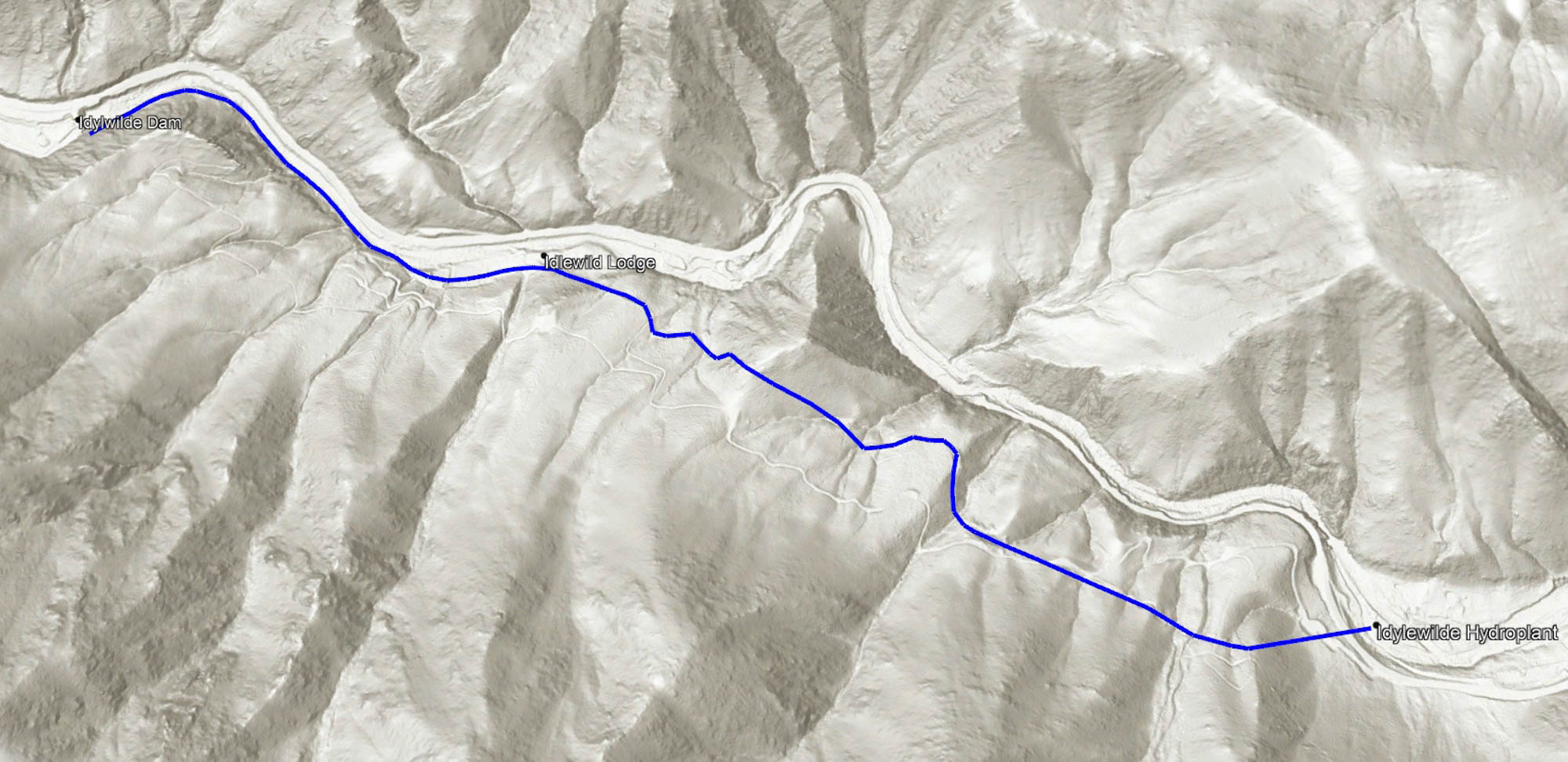
Map that shows the Idylewilde Penstock Pipeline in relation to Idylewilde Dam, Idylewilde Hydroplant, and Idlewild Lodge.3Esri. “Topographic” [basemap]. Scale Not Given. “World HIllshade”. 2022. (May 25, 2021). Using: Google Earth for Desktop, Version 7.3.4.8248: Google LLC, 2020. The Idylewilde Pipeline is highlighted in blue.
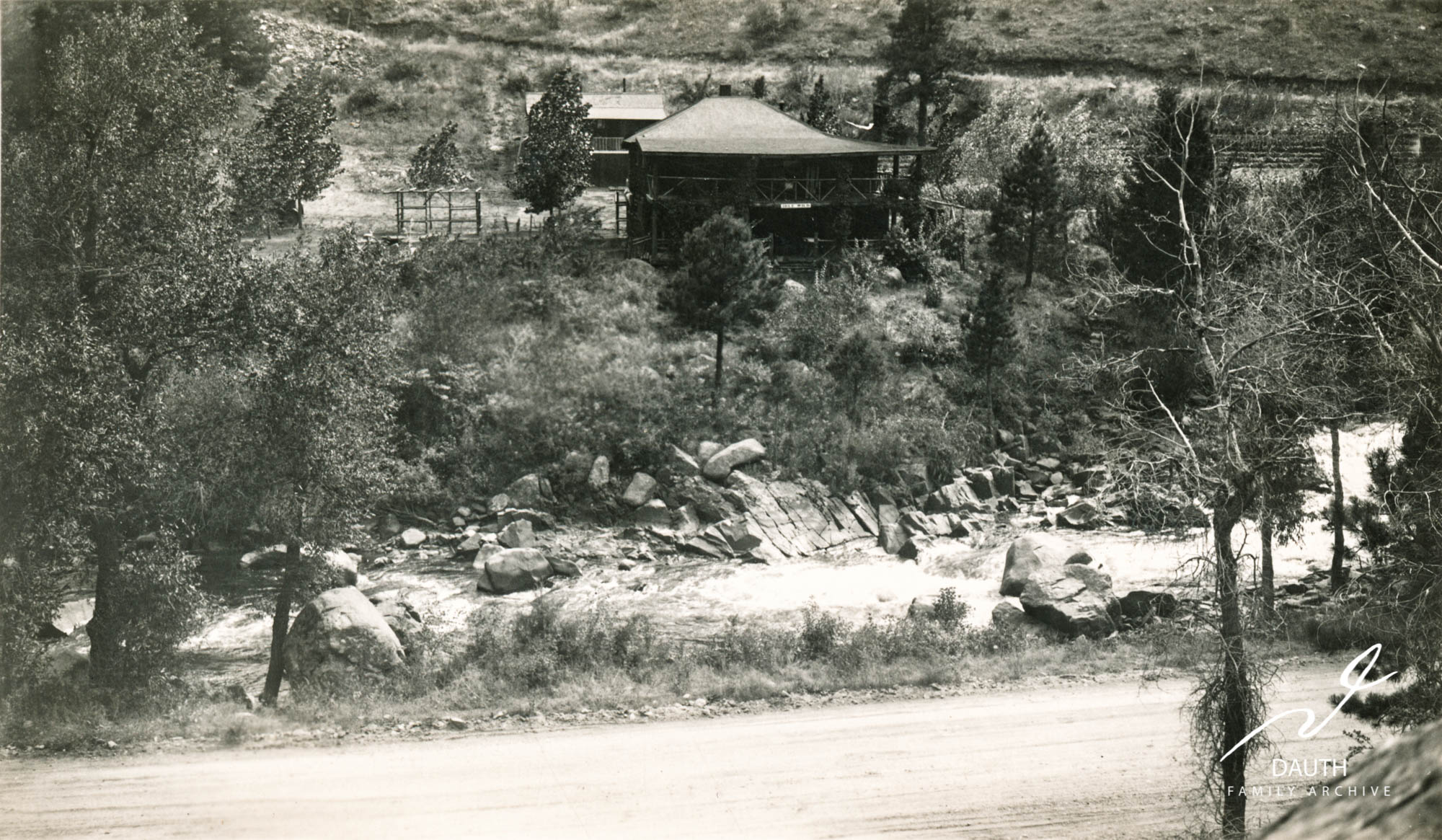
A late 1920s photo showing the Idylewilde Penstock Pipeline on the hillside behind Idlewild Lodge. The pipeline is seen as a horizontal excavation across the side of the mountain.
In a unique form of compensation for building through the Idlewild community, the City of Loveland gave residents free taps into the pipeline. Idlewild Lodge was granted three of these taps, and they began flowing February 11th, 1925.4City of Loveland Water and Power Department. (2012). City of Loveland Hydroelectric Plant 1912-July 31, 1976.
George Dauth immediately put the water to use and constructed a pond just to the west of Idlewild Lodge.
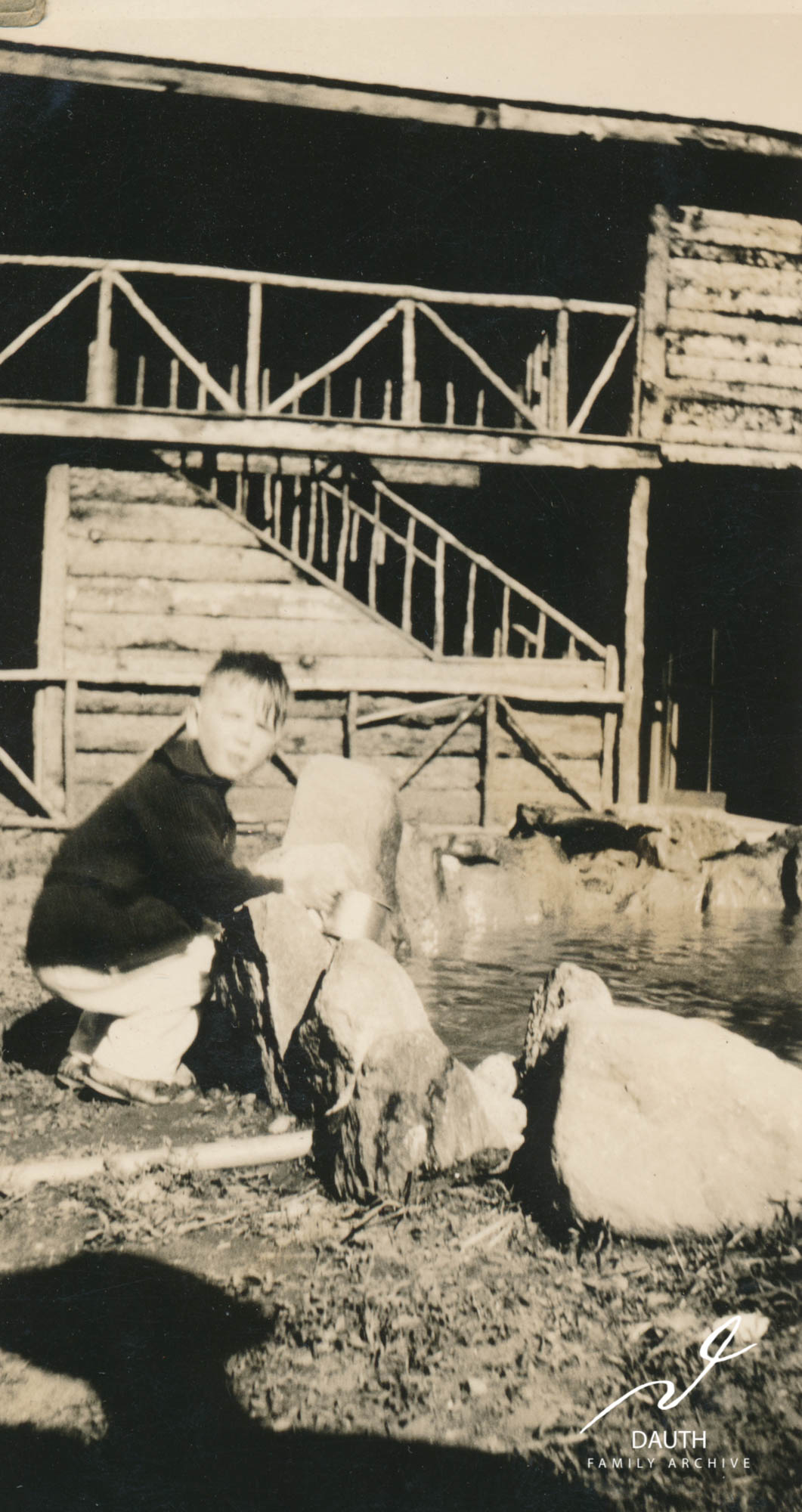
An unknown boy by the first pond at Idlewild, located just to the west of Idlewild Lodge. The pond received a continuously flowing water supply during the summer months and was turned off during the winter to prevent the taps from freezing.
Following the pond came the first plantings at Idlewild. A half dozen Freemont cottonwoods were put in directly south of the Lodge.

Four recently planted Freemont cottonwoods southeast of Idlewild Lodge.
A grape trellis was also put in at this time to cover the Lodge’s western patio.

The grape trellis over the Lodge’s patio, built to provide a shaded sitting area. Also visible are two Freemont cottonwoods planted southwest of Idlewild Lodge. The Freemont cottonwood near the center of the photo was cut down in 2019, more than 90 years after this photo was taken.
After the success of these initial plantings, George began the construction of an orchard. All of the land west of the Lodge was plowed in preparation.
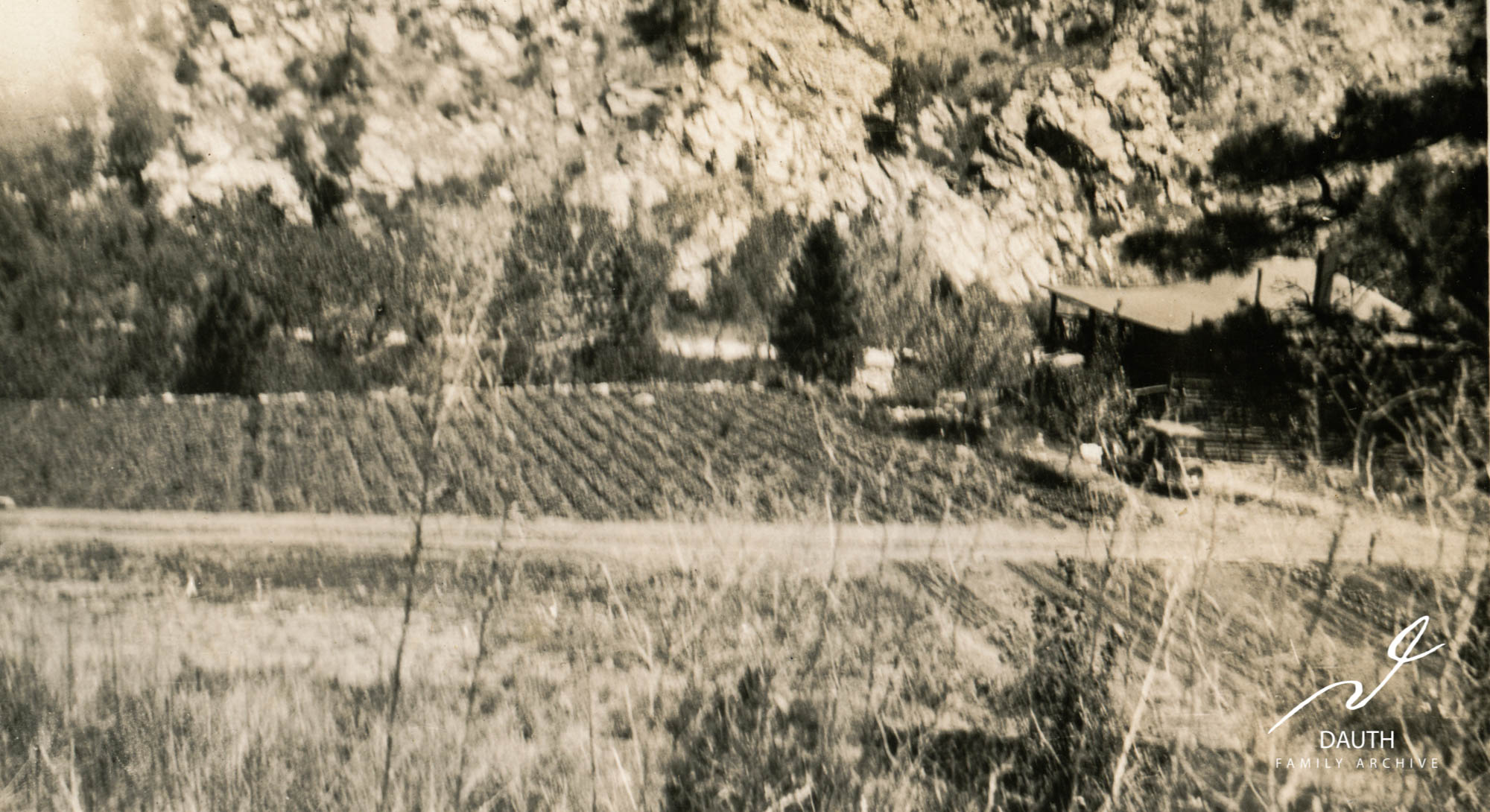
Freshly plowed furrows west of Idlewild Lodge.
Here dozens of tart cherries were planted.

Photo shows the northern side of Idlewild (left side of image) with dozens of recently planted cherry saplings.
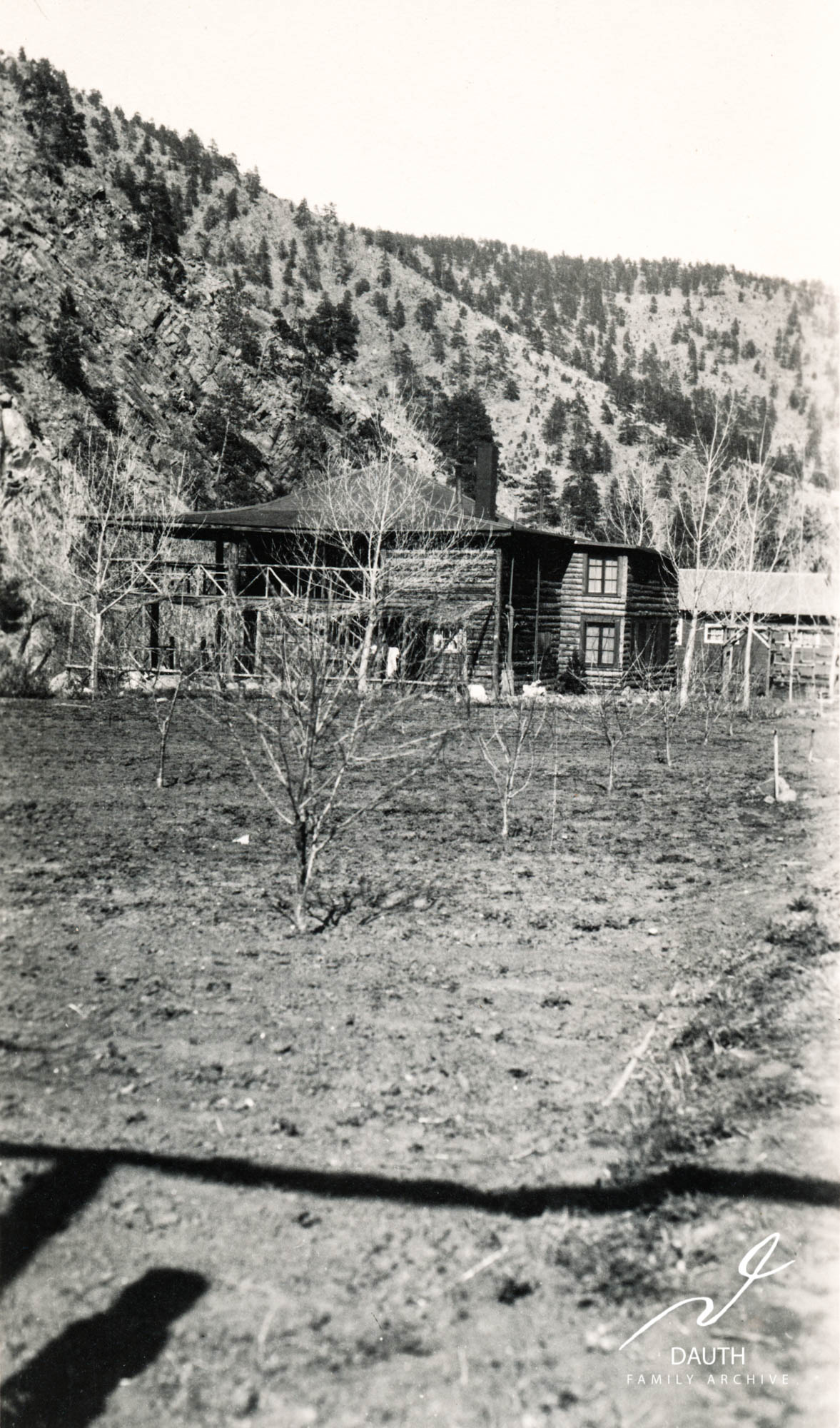
The tart cherry trees during the winter after a few years of growth.
The southwest corner of the property was then prepared for the planting of a large vegetable garden.
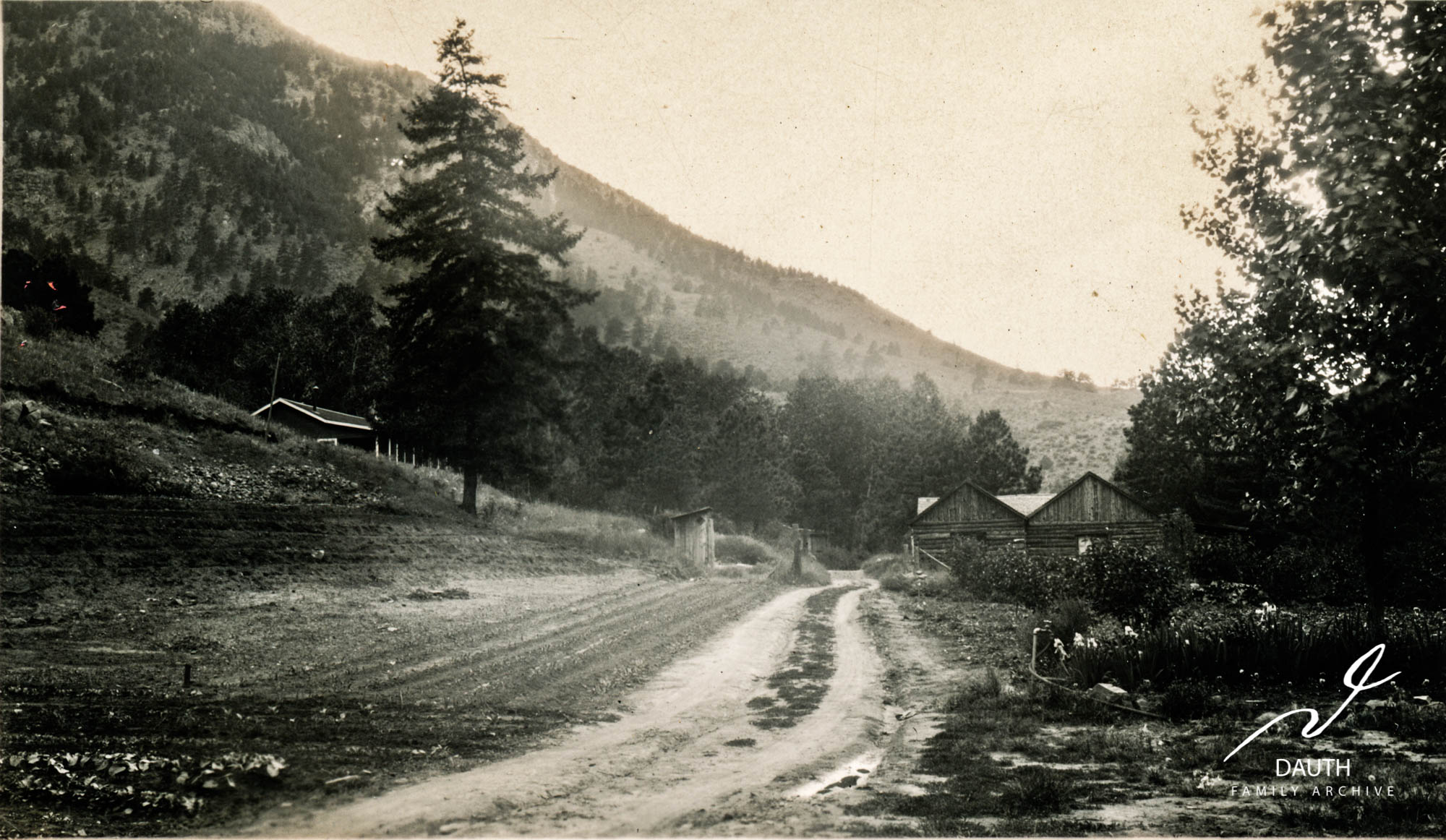
Photo shows the freshly plowed grounds on the southern side of Idlewild (left side of road). On the right are the tart cherry trees planted a year or two before.
A variety of crops were planted including corn, cabbage, lettuce, squash, cucumber, onion, carrots, radishes, beets, plums, apricots, and gooseberries. These foods were used to prepare meals for the first guests of the Lodge, in particular, the sororities of Colorado Teachers College, chaperoned by Florence Dauth.
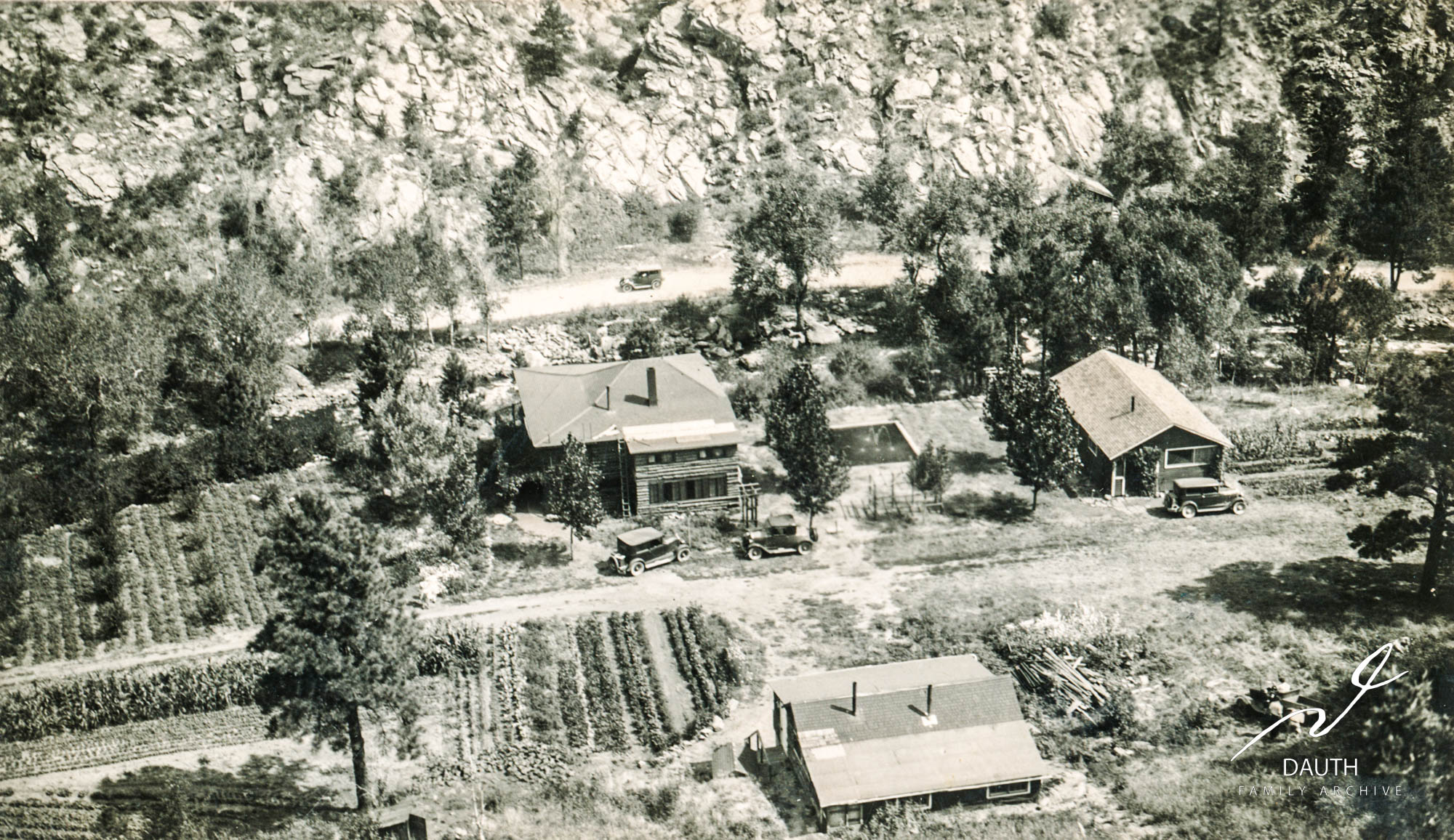
The fully planted Idlewild vegetable garden is seen near the bottom left of the photo. c. 1929.
Following the vegetable garden George began planning an extensive landscaping project east of the Lodge. In 1928 he commissioned a landscape architect to help with the design.

Garden development blueprints for “The George Dauth Summer Home” c. 1928.
The plans show a pond, decorated with rock boulders, as the centerpiece of the gardens. Connected to the pond by a stone pathway was a “Rustic Terrace Summer House” covered in climbing vines. Planted throughout, and surrounding, the gardens are over 80 varieties of flowers, shrubbery, and trees. Three arbors and a stone staircase provide access to the enclosed gardens.
While these plans were not strictly followed, they served as a template for George, and he began by constructing the blueprint’s central pond.
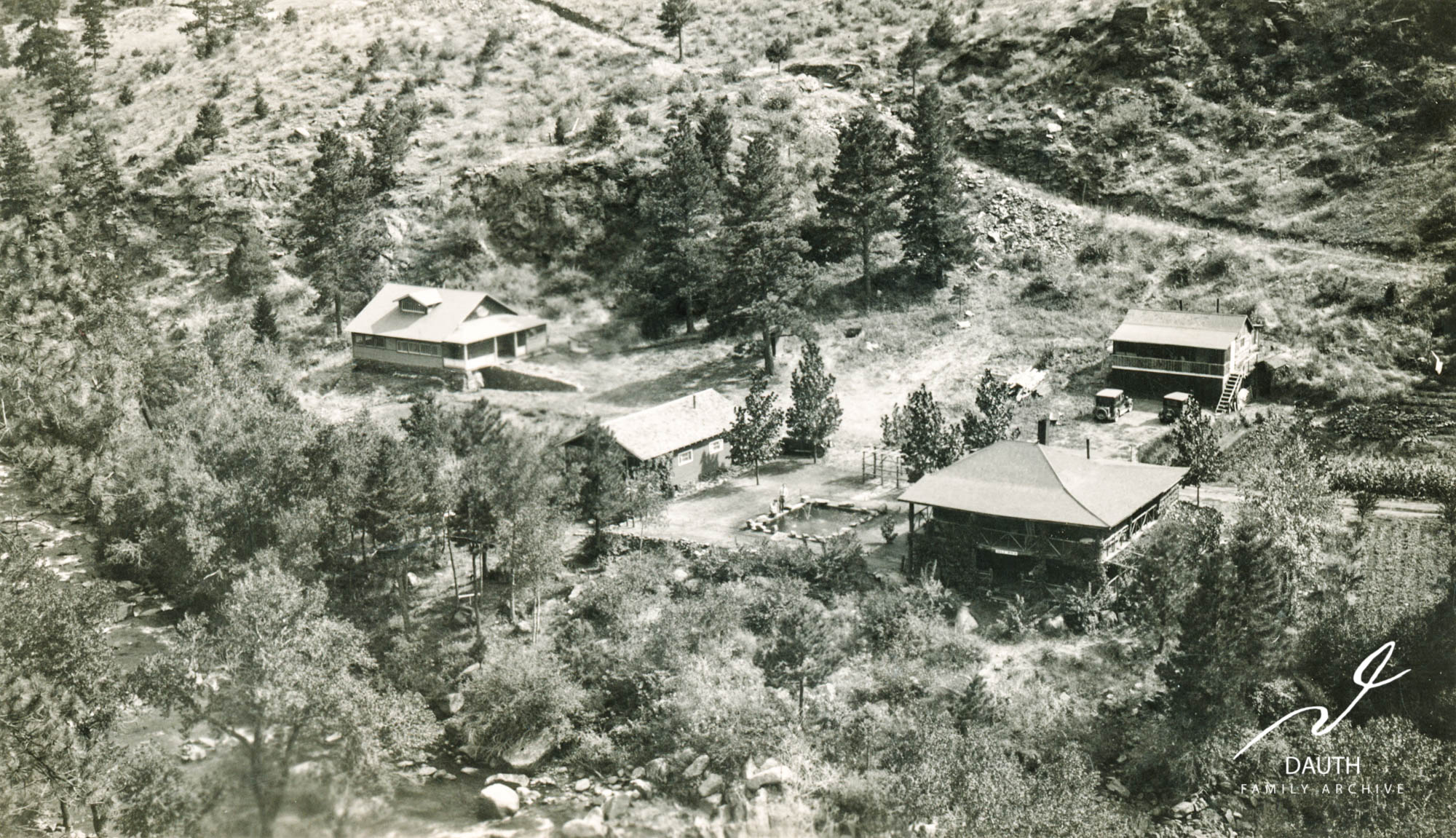
Idlewild c. 1928 showing the new pond east of Idlewild Lodge. Its positioning, square shape, and decorative rock border closely resemble the original blueprints.
The “Rustic Terrace” and stone walkway from the blueprints were also constructed.

Closeup of the above photo showing a stone path leading from the pond to a pergola covered terrace. Partly obscured towards the left of the photo, is one of the arbors depicted in the blueprints.
After these structures were built, flowers were planted. A simple selection of roses, pansies, asters, phlox and snapdragons were chosen, in lieu of the ambitious plant variety proposed in the blueprints.
By September 1929, the new plants had taken hold and the Dauths began inviting guests to enjoy the lily pond and blooming flowers:
Kensington Members and Husbands Entertained at Montain Home
Kensington members and their husbands were entertained Sunday by Mrs. George Dauth at her beautiful rustic mountain home, Idlewild. A four-course dinner was served by the hostess, assisted by Mrs. Mary Craig, Mrs. Pauline Boomer, and Mrs. Mabel McCreery. Table decorations were of California poppies and sprays of autumn leaves, with tiny pine cones marking each place card. Visiting guests included Mr. and Mrs. Blair Rugh; Mrs. Van Kirk of Wichita, Kans.; Mr. and Mrs. C. H. Barney of Manitou; Mrs. Syrena Pendexter of Cornish, Me.; Mrs. Louise Clark; Elizabeth Boles and Charles Darling. The Dauth gardens have been landscaped and include two lily ponds and a fountain. Pink and red roses, pansies, asters, phlox and snapdragons are now in bloom, making a colorful setting for the mountain home.51929-09-24 – Greeley Daily Tribune
Greeley Daily Tribune – September 24, 1929
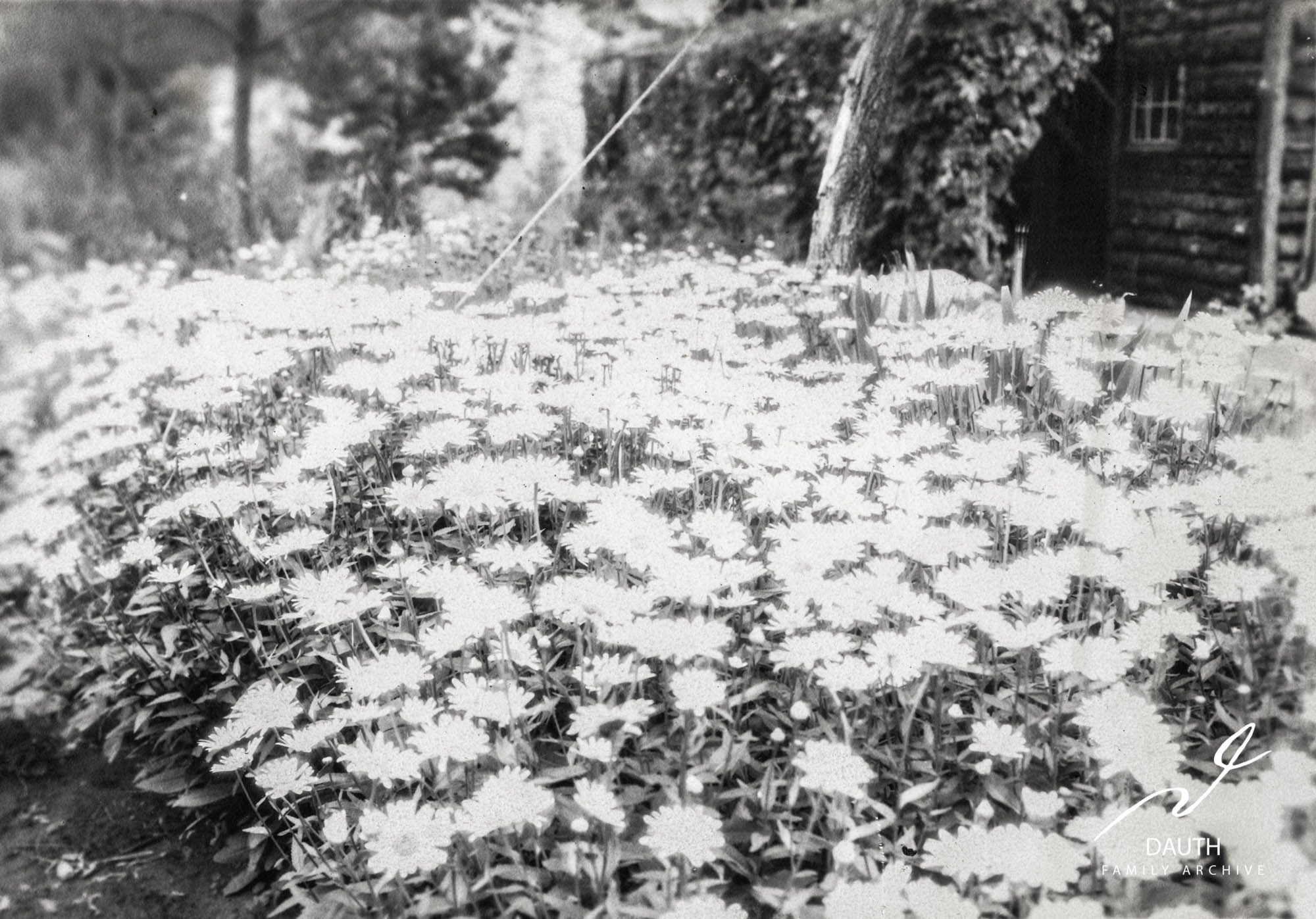
Flowers in full bloom west of the Lodge c. 1930s.
During the following years the pond was redesigned by removing the decorative rocks.
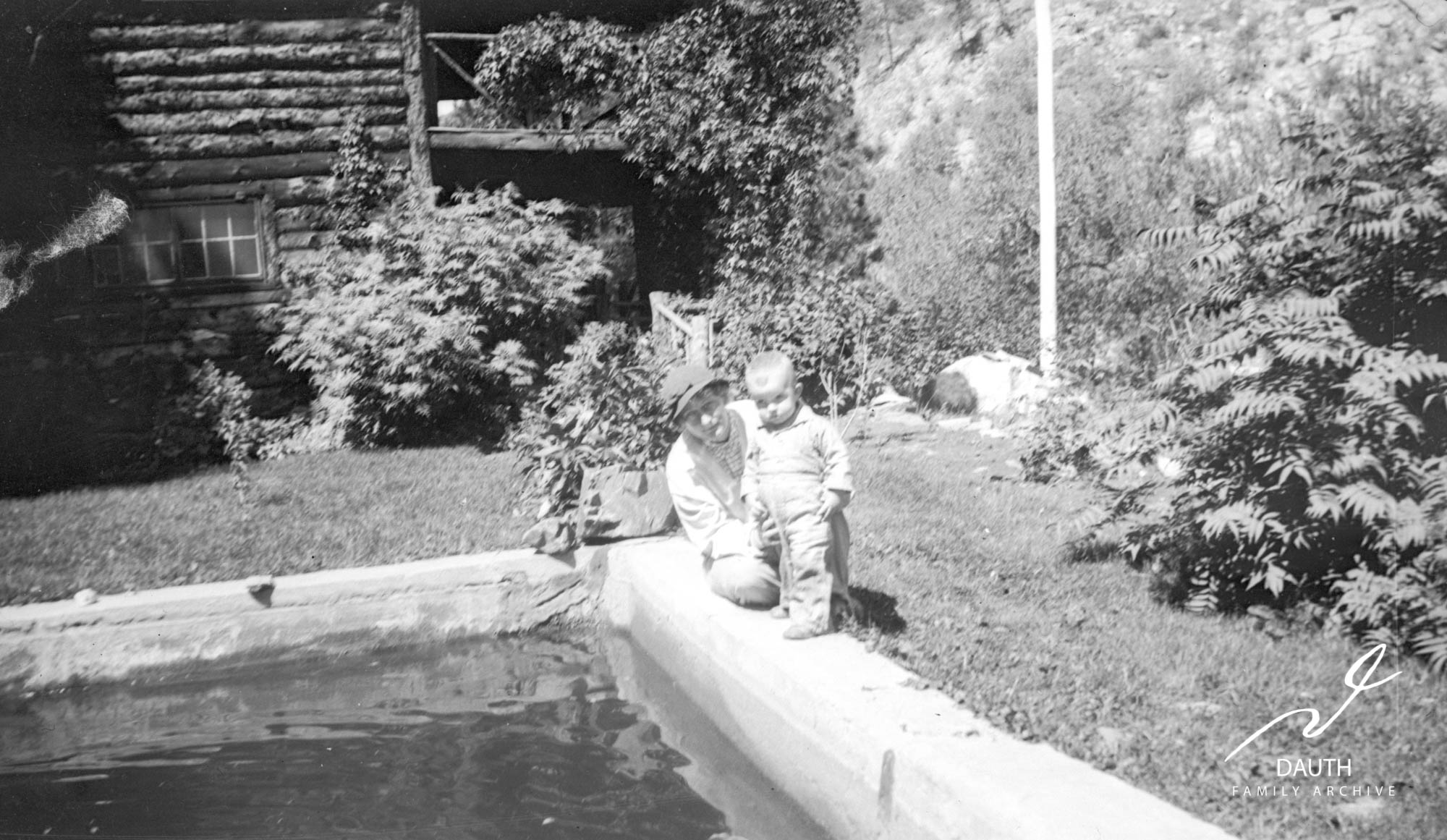
The remodeled lily pond without its decorative rock border c. 1930s.

Anna Dauth (right) with a friend at the remodeled lily pond. At the forefront is the pond fountain, fed by a tap on the Idylewilde Penstock Pipeline.
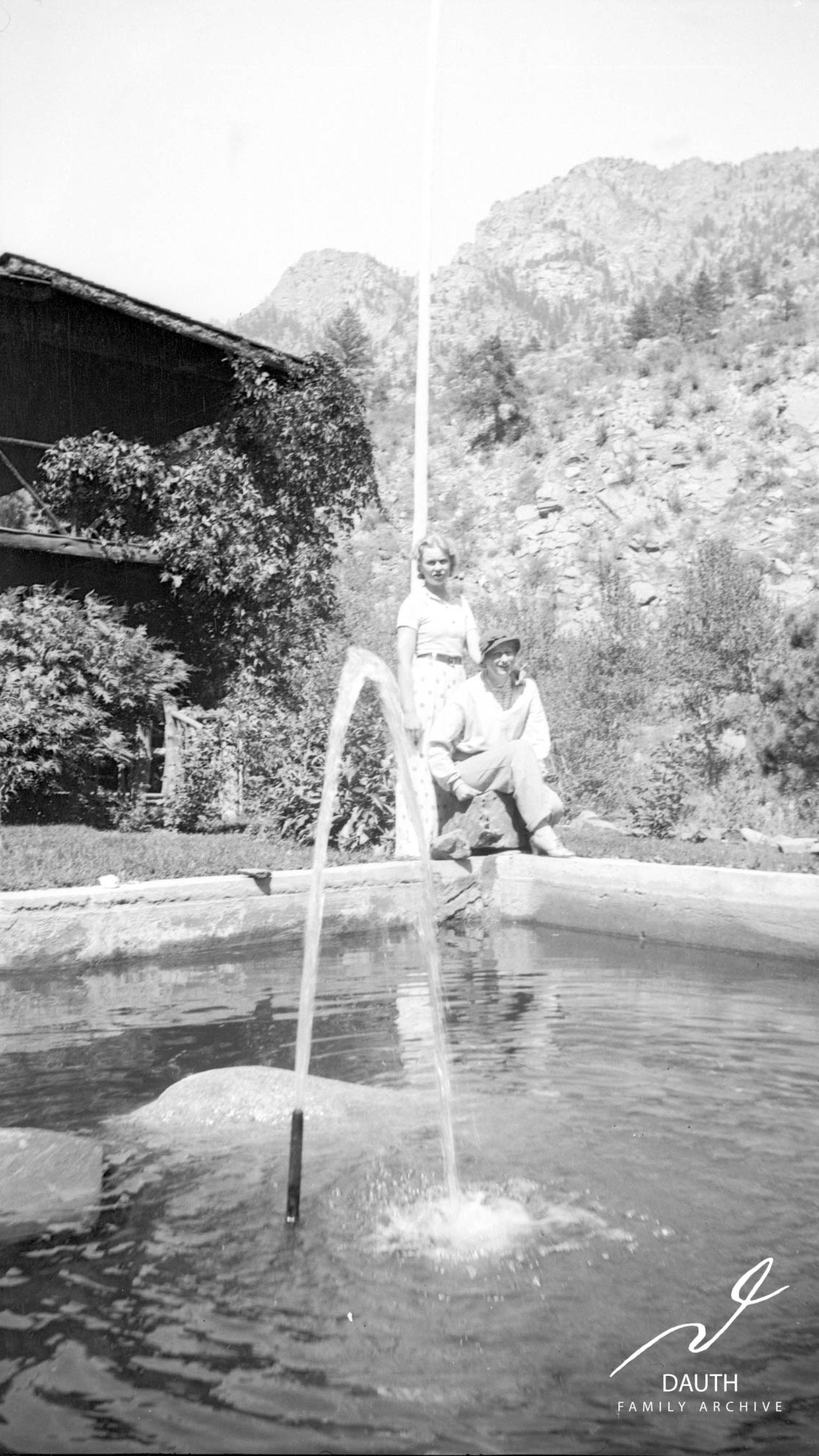
A second photo of Anna Dauth (left) with a friend at the lily pond. Thick shrubbery and grape vines now covered the Lodge’s eastern side up to the second floor.
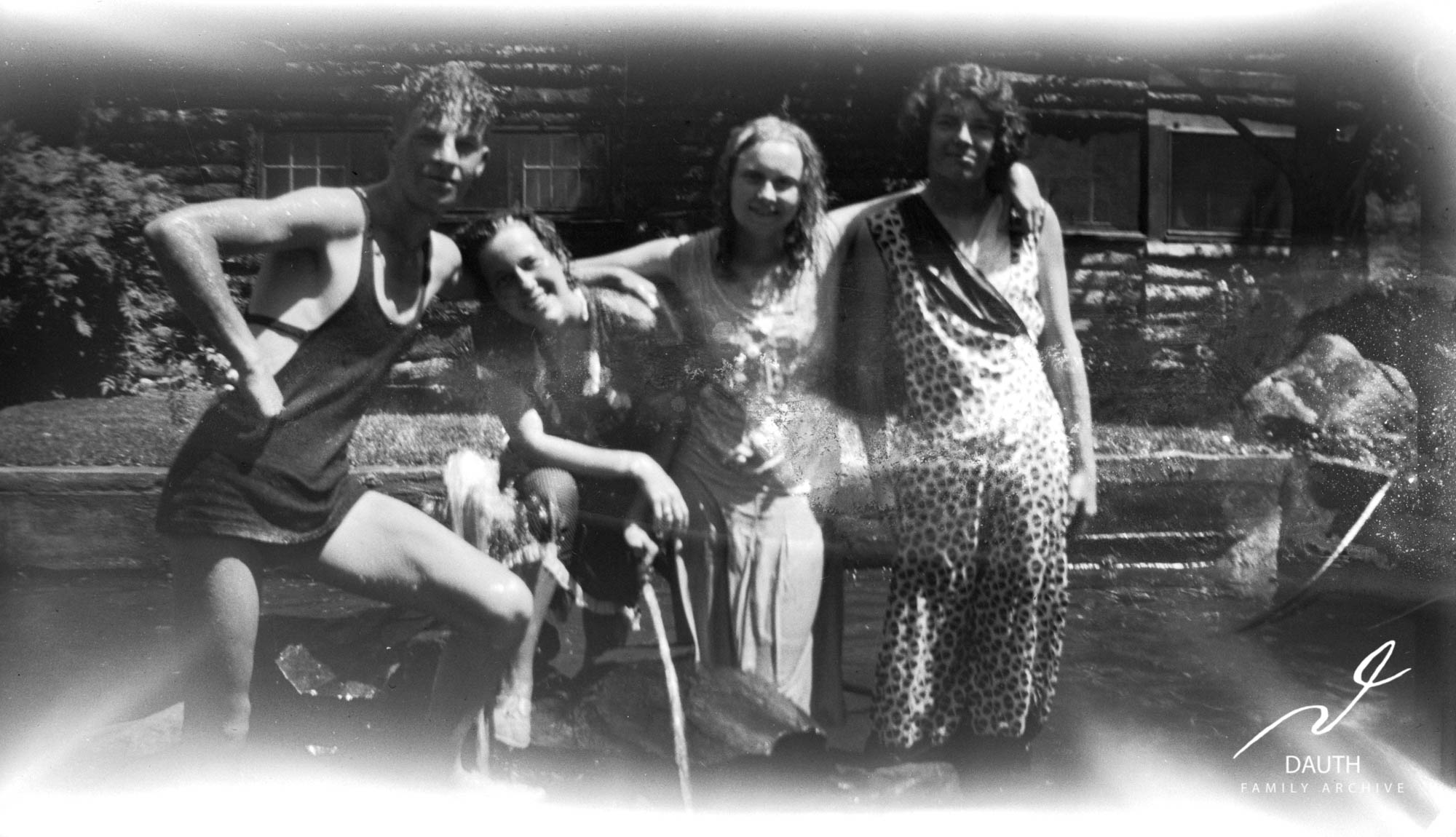
Anna Dauth (2nd from right) with friends in the remodeled pond c. 1930s.
By the 1930s George Dauth had become an experienced tree planter. He had started a tree farm in Greeley known as “Dauth’s Grove” to help him raise thousands of trees, which were planted in Greeley’s parks, Glen Haven, and Idlewild.61910-07-28 – The Greeley Tribune71930-03-13 – Greeley Daily Tribune81936-04-29 – Greeley Daily Tribune91937-05-26 – Greeley Daily Tribune
At Idlewild he used his trees to create another orchard, this time with apples. About a dozen dessert Jonathan apples along with a dozen cooking crab-apple saplings were put in the southwest corner of the property.

George Dauth planting apple trees at Idlewild Lodge c. 1937.

George Dauth caring for the apple trees southwest of Idlewild Lodge c. 1937. George Dauth’s secondary home is visible in the background.
George also used his farmed trees to populate a five level terrace overlooking the Big Thompson River. Over a hundred red cedar trees would be planted here.
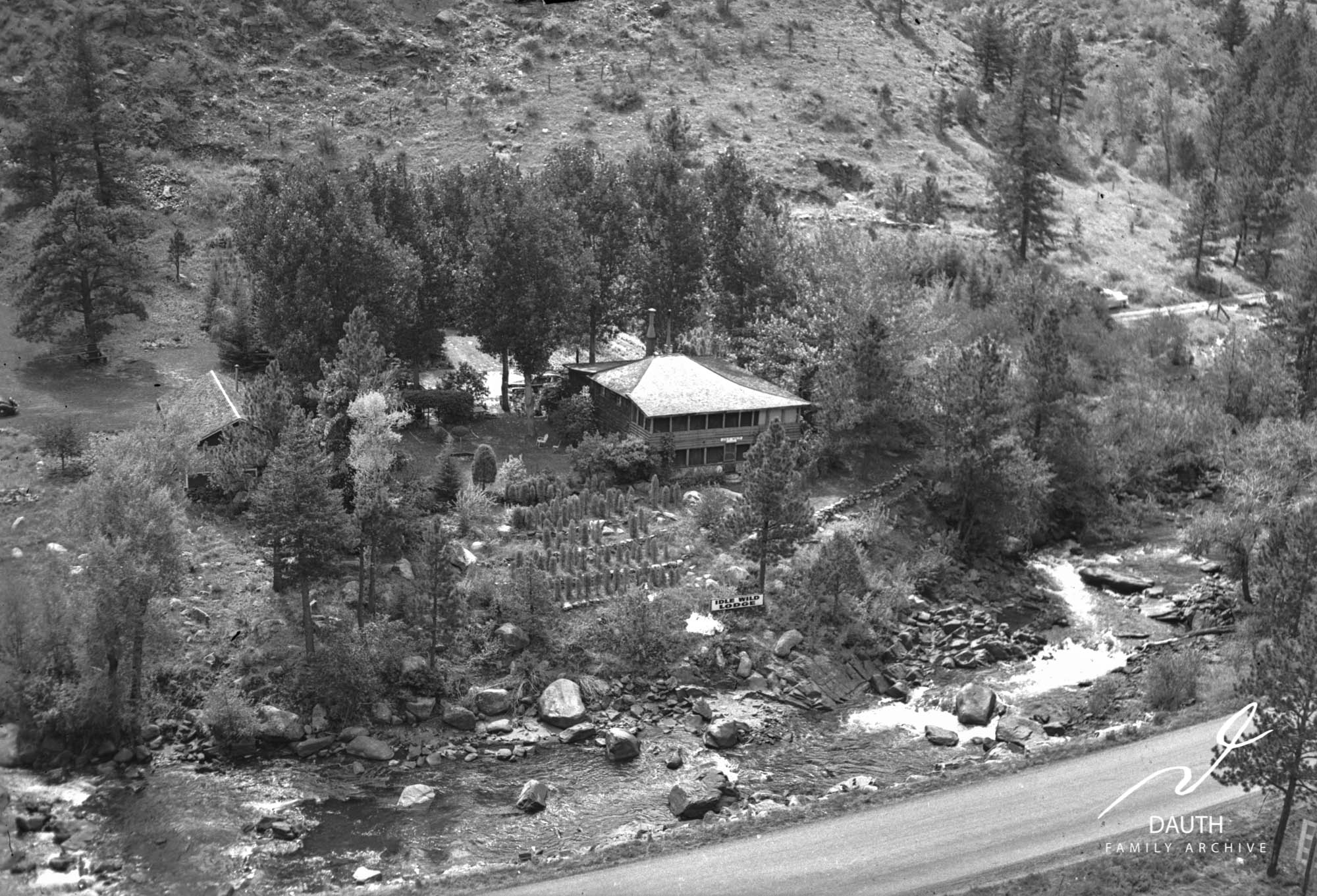
Looking southwest at the five tiered terrace in front of Idlewild Lodge, planted with over a hundred red cedars c. 1940.
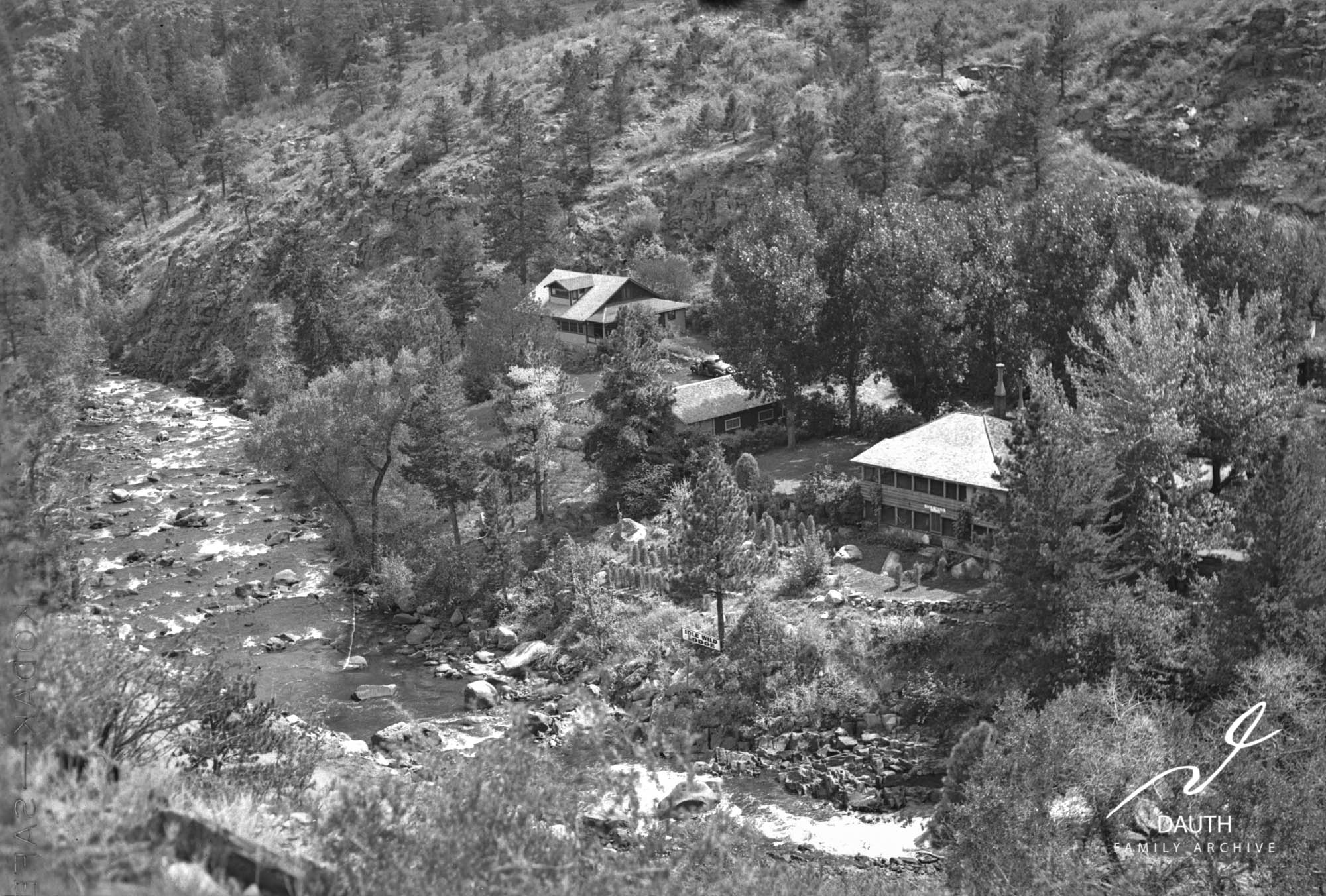
Looking southeast at the red cedar terraces c. 1940.
His trees were also used on a terrace located behind the lodge. Two dozen blue spruce trees were planted in a large rectangle to create an enclosed courtyard.
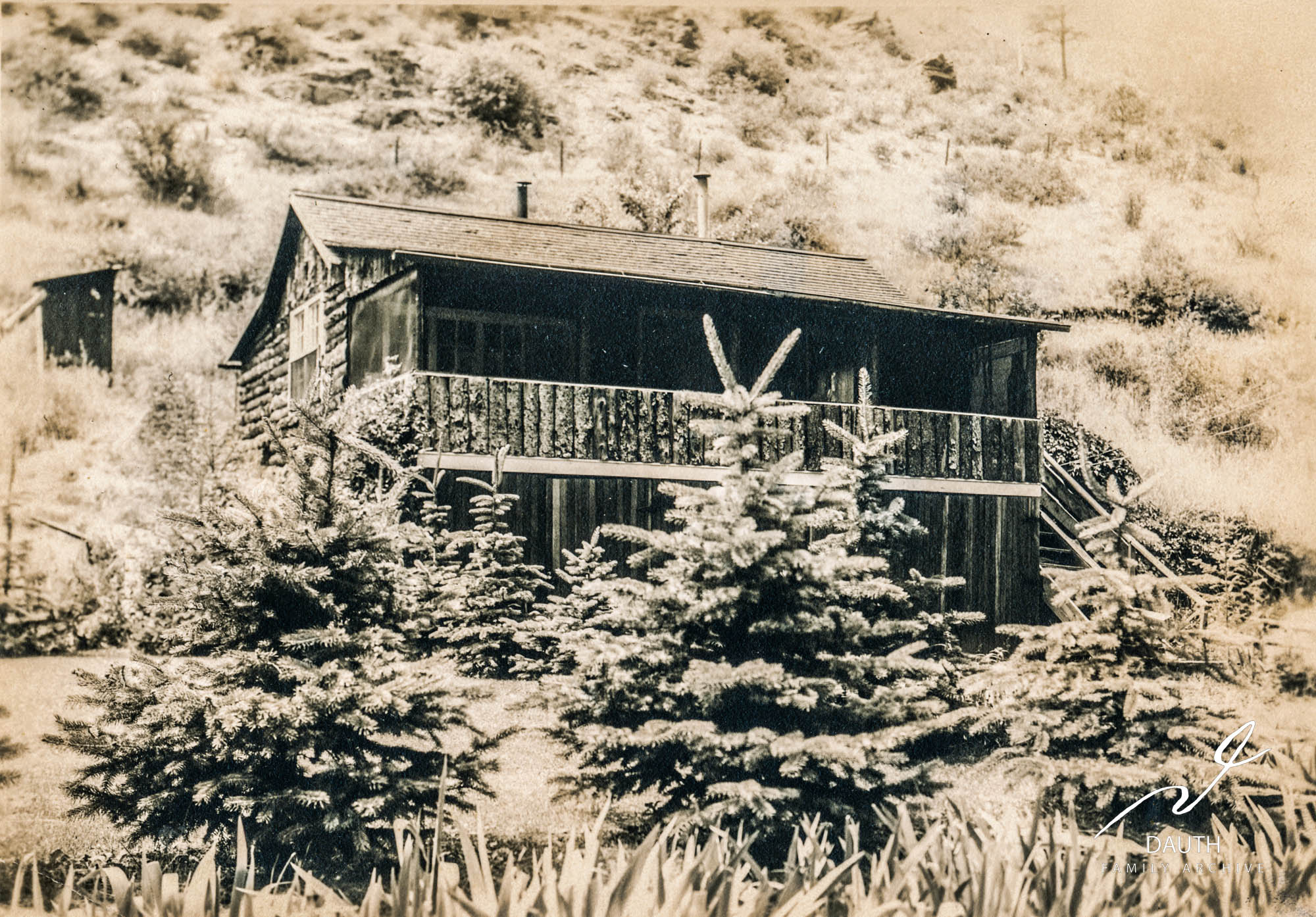
Recently planted blue spruces on the terrace behind Idlewild Lodge. Tulips are also visible planted among the trees.

Idlewild as seen from the slope of Sheep Mountain c. 1939. The blue spruce courtyard is seen at right and vegetable garden at left.
As the trees grew and enclosed the courtyard, the space was used as a badminton court, where family, friends, and guests at the Lodge could relax and play.
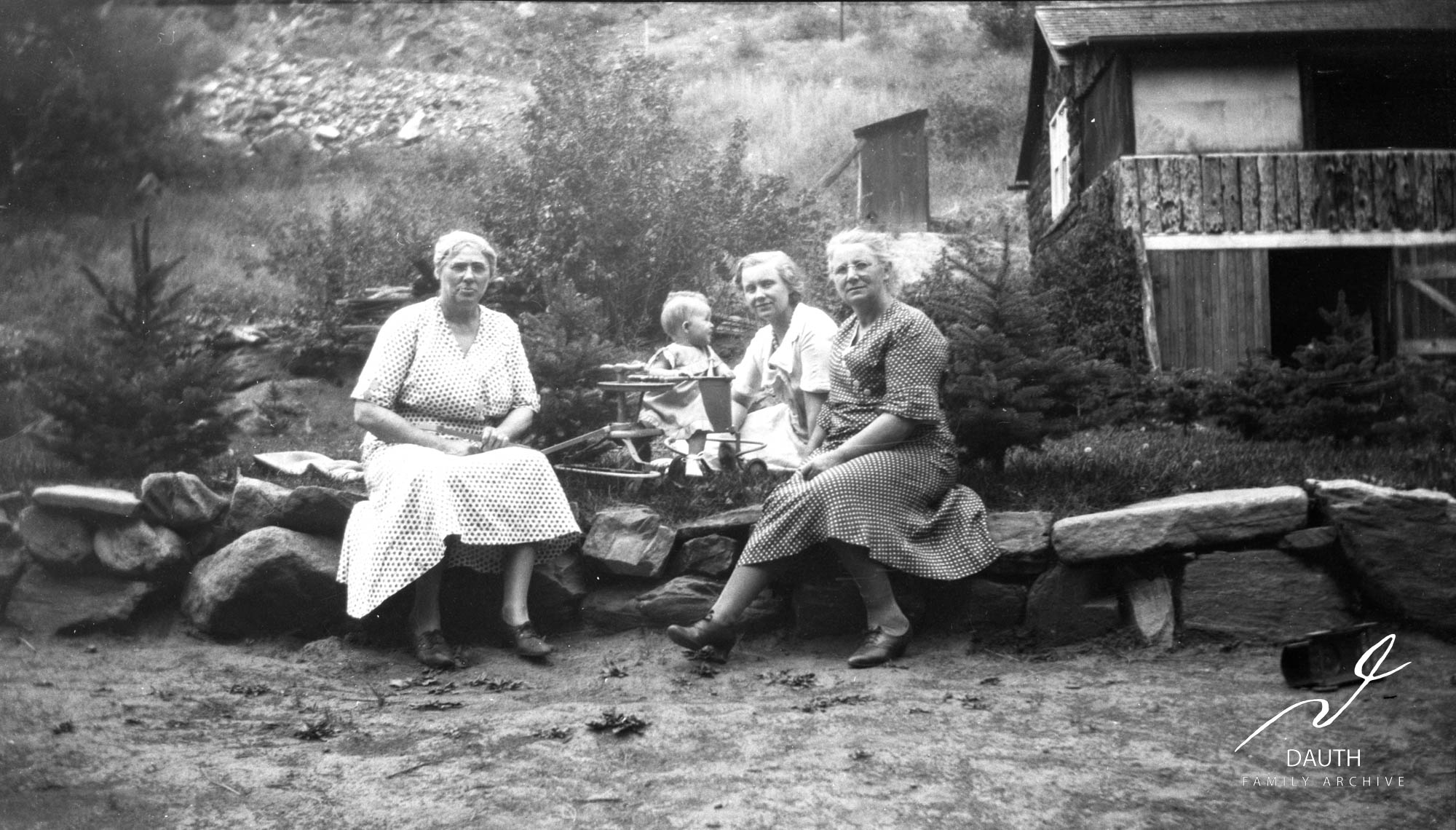
Members of the Dauth Family sitting by the blue spruce terrace c. 1939. Florence Dauth (left), Carrie Jeremiassen (right), Anna Dauth (2nd from right), Jerry Dauth (2nd from left).
In the early 1940s the pond east of Idlewild was once again redesigned. It was made much smaller and shaped into an octagon.

The octagonal redesign of the pond. Shown are Leslie Dauth, son of George Dauth, with Leslie Ann Dauth, granddaughter of George Dauth, and Spot the dog.

The new lily pond as seen within the courtyard c. 1940s.

The octagon pond now decorated with a colorful mix of tulips. Behind the pond are Anna Dauth, daughter-in-law of George Dauth, with grandchildren Jerry and Leslie Ann Dauth c. 1940.
By this point, George had been working on the gardens tirelessly for over twenty years. What was once a rocky and treeless landscape was now blooming with life. His hard work and dedication had payed off.
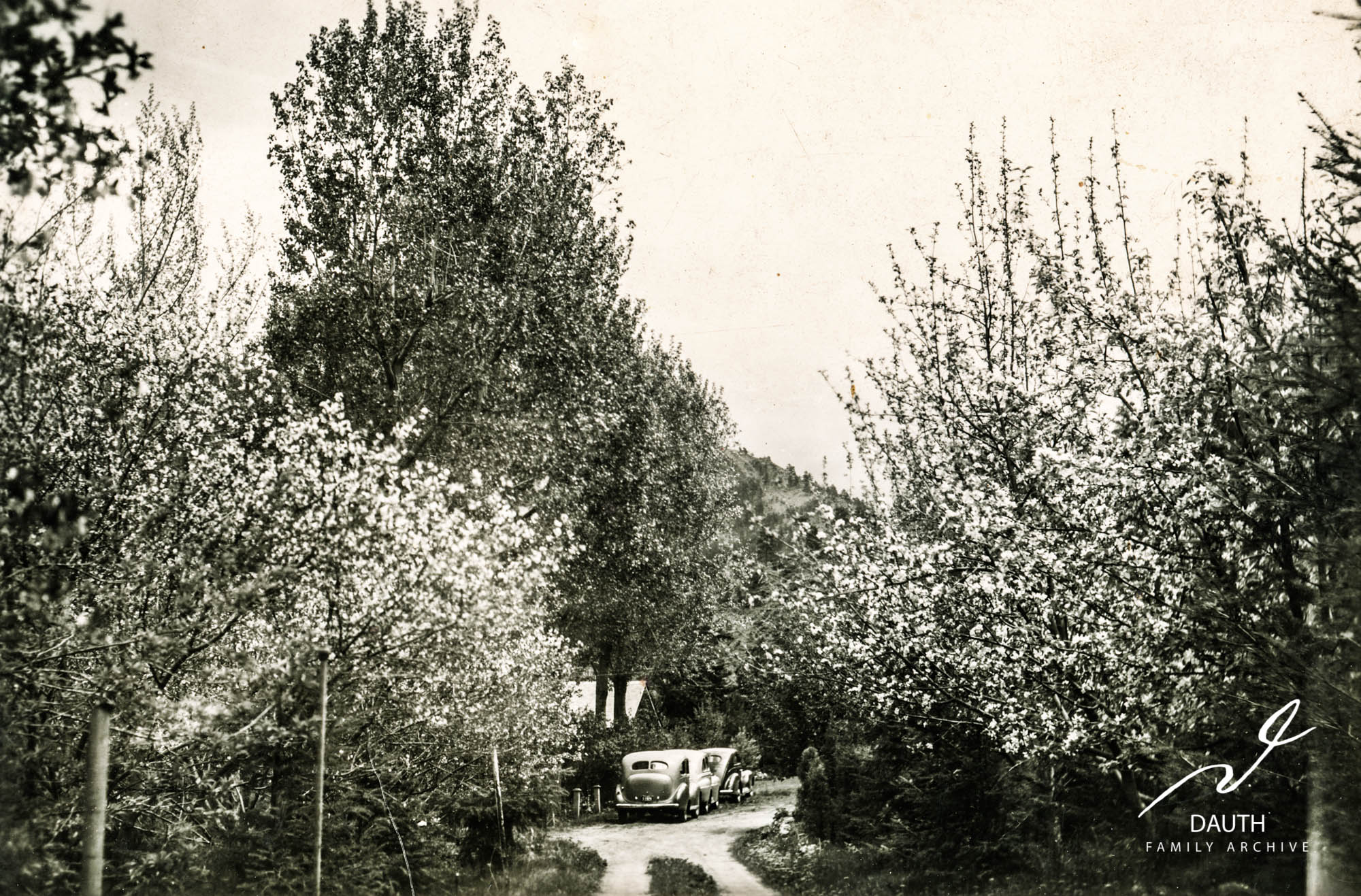
Dozens of blossoming fruit trees on the road leading to Idlewild Lodge. Tart Cherry trees are on the left hand side of the road while apple trees are on the right. c. 1940s

Anna Dauth (middle) and Florence Dauth (right) picking cherries at Idlewild.
Years passed and George grew older, but he never stopped working on the gardens. Up until his final years he could be found at Idlewild every summer tirelessly caring for the flowers and trees.

George and Florence Dauth with their son Leslie Dauth and grandchildren Leslie and Jerry Dauth enjoying the Idlewild gardens c. 1940s.
Its been nearly a century since George planted the first trees at Idlewild and much has changed. Many of the trees grew tall, lived their lives, and are now gone. Idlewild’s water supply was lost after the 2013 flood destroyed the pentock pipeline. The ponds went dry and the gardens eventually gave way to the native grasses.
But reminders of George’s legacy still exist. Dozens of his trees have persevered to this day. The blue spruce courtyard now towers high above the cabins. Wild apple and cherry trees, descendants of the original orchard, now provide food for the local wildlife. And every year a bloom of George’s surviving flowers still paint the landscape with a vibrant and colorful display.

